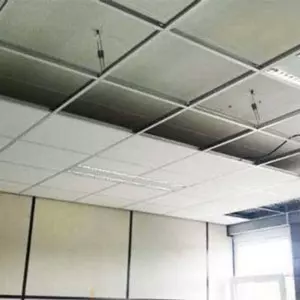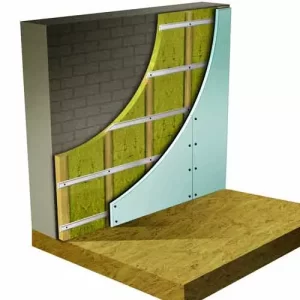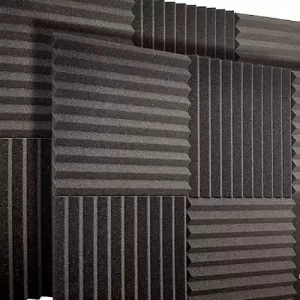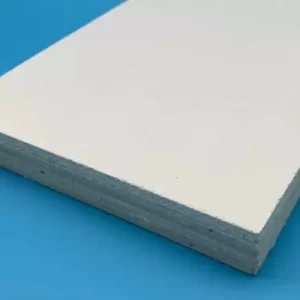Grid False Ceiling Acoustic Properties: Enhancing Sound Control in Interior Spaces
Introduction
In modern interior design, the integration of functional and aesthetic elements is crucial for creating harmonious and comfortable spaces. One aspect that plays a significant role in achieving this balance is the selection of appropriate ceiling systems. Grid false ceilings, also known as suspended ceilings, have gained popularity due to their versatility and ability to enhance acoustic properties in various environments. In this article, we will explore the acoustic properties of grid false ceilings and how they contribute to sound control in interior spaces.

Understanding Grid False Ceilings
Grid false ceilings, also referred to as suspended ceilings, are secondary ceilings installed beneath the primary structural ceiling. These ceilings consist of a grid framework of metal or other materials, supporting lightweight panels that are easily removable. Grid false ceilings offer several advantages, including easy installation, accessibility to services above the ceiling, and the ability to create a uniform and finished appearance.
The Importance of Acoustic Control

Acoustic control is crucial in interior spaces, whether it’s an office, educational institution, healthcare facility, or entertainment venue. Unwanted noise, echoes, and poor speech intelligibility can significantly impact the comfort and productivity of occupants. Grid false ceilings play a vital role in controlling these acoustic issues by enhancing sound absorption, sound insulation, and speech intelligibility.
Sound Absorption
H1: What Is Sound Absorption?
Sound absorption refers to the ability of a material or surface to absorb sound energy rather than reflecting it back into the space. By reducing sound reflections, sound absorption helps in controlling reverberation and minimizing noise levels. In grid false ceilings, sound absorption is achieved through the use of acoustic panels or tiles.
H2: Materials Used for Sound Absorption
Grid false ceilings incorporate various materials that possess excellent sound absorption properties. These materials may include mineral wool, fiberglass, perforated metal panels, or specialized acoustic tiles. These materials are designed to absorb sound waves across a broad frequency range, effectively reducing reverberation and enhancing overall acoustic comfort.
Sound Insulation

H1: What Is Sound Insulation?
Sound insulation, also known as soundproofing, refers to the prevention of sound transmission between different spaces. It is particularly essential in areas where privacy and confidentiality are crucial, such as meeting rooms, conference halls, or medical facilities. Grid false ceilings contribute to sound insulation by creating an additional barrier that reduces the transmission of airborne sound.
H2: Enhancing Sound Insulation with Grid False Ceilings
Grid false ceilings enhance sound insulation by adding mass and damping properties to the ceiling assembly. The materials used in the construction of the suspended ceiling system, such as dense mineral wool or composite panels, act as barriers to airborne sound transmission. By minimizing sound leakage, grid false ceilings help maintain privacy and create acoustically isolated spaces.
Noise Reduction Coefficient (NRC)
H1: What Is the Noise Reduction Coefficient (NRC)?
The Noise Reduction Coefficient (NRC) is a numerical rating that indicates the sound absorption capability of a material or surface. It represents the average sound absorption across a range of frequencies, with higher values indicating better sound absorption. Grid false ceilings with higher NRC values contribute to improved acoustic performance and reduced noise levels.
H2: Achieving High NRC with Grid False Ceilings
Grid false ceilings can achieve high NRC ratings by incorporating sound-absorbing materials with optimized surface textures. The use of perforated panels, specialized acoustic tiles, or fibrous materials enhances sound absorption and helps achieve desired NRC values. By implementing grid false ceilings with high NRC, interior spaces can benefit from reduced reverberation and improved overall sound quality.
Speech Intelligibility
H1: What Is Speech Intelligibility?
Speech intelligibility refers to the clarity and understandability of speech in a given space. Poor speech intelligibility can hinder effective communication and lead to increased stress and frustration. Grid false ceilings contribute to improved speech
intelligibility by reducing reverberation, minimizing background noise, and enhancing sound directivity.
H2: Enhancing Speech Intelligibility with Grid False Ceilings
Grid false ceilings with excellent sound absorption properties help minimize the reflections of sound waves, ensuring that speech is clear and intelligible. By reducing excessive reverberation, grid false ceilings improve the signal-to-noise ratio, allowing speech to be heard more distinctly. This is particularly beneficial in classrooms, conference rooms, or auditoriums where effective communication is essential.


Design Flexibility and Aesthetics
H1: Design Flexibility of Grid False Ceilings
Grid false ceilings offer tremendous design flexibility, allowing for creative and customized ceiling designs. The modular nature of the system enables easy integration of lighting fixtures, air conditioning vents, and other services. Additionally, the grid framework can be configured to accommodate different panel sizes and shapes, providing architects and designers with endless possibilities to create unique and visually appealing ceiling designs.
H2: Aesthetic Options for Grid False Ceilings
Grid false ceilings are available in a wide range of materials, finishes, and colors, enabling seamless integration with the overall interior design concept. From clean and minimalistic designs to artistic patterns and textures, grid false ceilings offer aesthetic options to suit various architectural styles and preferences. These ceilings not only enhance acoustic performance but also contribute to the overall visual appeal of the space.


Applications of Grid False Ceilings
Grid false ceilings find applications in a variety of settings, including:
- Offices and commercial spaces
- Educational institutions
- Healthcare facilities
- Hospitality venues
- Entertainment and performance spaces
- Retail environments
The versatility and acoustic properties of grid false ceilings make them a popular choice for creating comfortable and visually appealing interior environments across different sectors.


Conclusion – Grid False Ceiling Acoustic Properties
Grid false ceilings play a vital role in enhancing acoustic control in interior spaces. By offering sound absorption, sound insulation, and improved speech intelligibility, these ceilings contribute to a more comfortable and productive environment. The design flexibility and aesthetic options of grid false ceilings further enhance their appeal in architectural and interior design projects.
Frequently Asked Question- Grid False Ceiling Acoustic Properties
- Can grid false ceilings completely eliminate all noise in a space?
Answer: While grid false ceilings significantly contribute to noise reduction, complete elimination of noise is not feasible. They help control noise levels and improve acoustic comfort. - How do grid false ceilings affect the overall height of a room?
Answer: Grid false ceilings are suspended below the primary ceiling, reducing the available height slightly. However, their benefits in terms of acoustics and aesthetics outweigh this minimal reduction in height. - Can grid false ceilings be installed in existing buildings?
Answer: Yes, grid false ceilings can be installed in existing buildings with the appropriate installation techniques. They offer a practical solution for retrofitting spaces to enhance acoustic performance. - Are grid false ceilings easy to maintain and clean?
Answer: Grid false ceilings are designed for easy maintenance and cleaning. The removable panels allow access to the space above, making it convenient to address any maintenance requirements. - Do grid false ceilings contribute to energy efficiency?
Answer: Grid false ceilings can contribute to energy efficiency by providing additional thermal insulation and accommodating energy-efficient lighting fixtures.
Grid Ceiling Products

PVC Gypsum Laminated Ceiling Tile

Metal Ceiling Tile

Mineral Fiber Ceiling Tile
Contact Us
Mobile: +919008400701 / 705
Email: sales@jayswalgroup.com

Visit Us
Address:
#6, 10th B Cross, Jayswal Center, KHB Main Road, Kaveri Nagar, Kanakanagar, RT Nagar, Bangalore – 560032, Karnataka, India.
Other Websites: